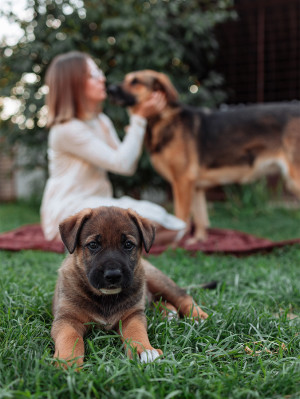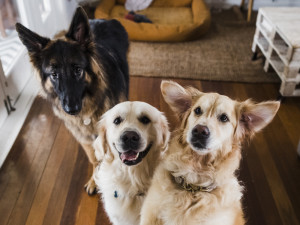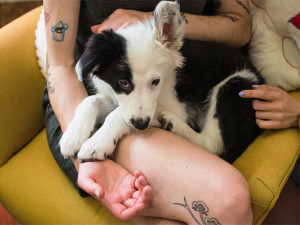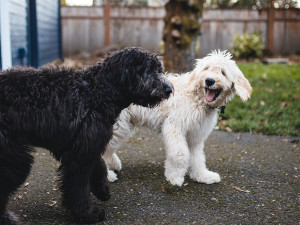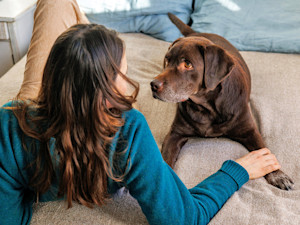Why Does My Dog Sigh?
They truly act like the weight of the world is on their shoulders.
In This Article:
Why Does My Dog Sigh? Common Reasons for Dog Sighing Situational Dog Sighing Dog Sigh Meaning Frequently Asked Questions
Following a day of snuggles, treats, and endless attention, does your dog ever let out the biggest sigh, as if they are the ones who have to pay taxes and go to work 40 hours a week? Come. On.
Dog sighing, however silly it seems, is a common behavior that can convey a range of emotions and physical states, such as relaxation. While a dog’s sigh is frequently a sign of contentment, it can also indicate other feelings, such as mild frustration, boredom, or even discomfort.
Why does my dog sigh? Common reasons for dog sighing
Again, no one seems to sigh more than a dog who doesn’t have a job, doesn’t pay bills, and has everything taken care of for them. So, what exactly do these sighs mean? Veterinary behaviorist Dr. Valli Parthasarathy shares that there can be a variety of meanings for a dog’s sighs, including contentment, discomfort, attention-seeking, frustration, and more.
How much do you spend on your pet per year?
Contentment and relaxation
Contentment and relaxation is one of the most common reasons for a dog to sigh, according to Parthasarathy. “If you have a dog who sighs every time they lay down, it is possible that they are getting comfortable, and they just are giving a big exhale of, ‘Okay, I’m comfortable now.”’
Sighs of contentment can be your dog’s way of letting you know they are comfortable and happy. They may occur when your dog is settling down after a walk or game of fetch, when they like the way you are petting them or when they are curling up for a nap. You can usually tell if a sigh is a “happy” sigh, or a sigh of relaxation based on the situation and your dog’s body language. Some other signs of contentment and relaxation include the following:
Your dog’s ears and tail are relaxed, not tense and alert
Your dog is wagging their tail
Their eyes look “soft,” or relaxed and half-opened
Communication
Your dog may sigh to communicate to you how they are feeling. My Corgi, Charlotte, certainly lets out a little “huff” when she drops a ball at my feet and I don’t immediately pick it up. A sigh can be a way to communicate a variety of things. They could be telling you they want to go outside, they want the food you’re holding, they don’t like how loud the TV is, or like Charlotte, they want you to throw that ball right now.
In addition to sighing, barking, and other vocalizations, body language is a major way that dogs communicate. “Ear position, tail position, whether they are looking out the side of the eye, all of these need to be taken in context,” Parthasarathy says. “If their ears are back, their tail is down, they’re licking their lips, they are typically more worried. If they are more relaxed, then their ears are in a relaxed position, their tail is in a relaxed position.”
Attention-seeking behavior
Dogs are smart, and some may realize that when they sigh or make a noise, you might look at them, pet them, or ask them what’s wrong. These little attention-seeking sighers might just be looking for some love and affection.
Mild frustration or boredom
In some cases, a sigh could signal that your dog is bored or frustrated. “I know my dog when he’s frustrated or has kind of given up, he gives a big sigh,” Dr. Parthasarathy says.
Other contextual signs can usually clue you in on a frustrated or bored sigh – they might be trying to play, they might be annoyed that you stopped petting them, or they might be looking for an activity after waking up from a nap.
If you suspect your dog is bored and needs a little extra stimulation, consider taking them on a walk, playing, or giving them an interactive treat or activity, like a Kong or snuffle mat.
Pain or discomfort
Pet parents should look out for sighs of pain or discomfort, since these could be an indication of a larger issue. Dr. Parthasarathy recommends observing when your dog sighs to assess for signs of pain: “Does it happen more at certain times of the day versus other times of the day? Does it happen more after exercise versus not? Does it happen when they are assuming specific positions, for example, every time they transition to a laying down position?”
You can also observe your dog’s body language and movement for other signs of pain, such as stiffness or limited mobility. The following are some common signs of dogs in pain:
Groaning, grunting, whining, or whimpering
Changes in daily activity or habits
Changes in facial expressions
Abnormal posture
If you have any concerns about your dog or suspect they are in pain, consult your veterinarian.
Brachycephalic breeds and heavy-breathing
Sighing could also just be a side effect of a dog’s breed. Brachycephalic breeds are those with shorter bone structures in the face and nose, resulting in restricted airflow through the nostrils. Since many of these breeds breath easier through the mouth than the nose, sighing may just be part of their breathing. The following are common brachycephalic breeds:
French Bulldogs
English Bulldogs
Boxers
Boston Terriers
Pekingese
Chinese Shar-Pei
Pugs
Lhasa Apsos
Shih Tzus
Bull Mastiffs
Situational dog sighing
Often, dog sighing is a result of a specific situation or action. These sighs could be a habit — like a human letting out an “ahh” after a sip of crisp soda — or another way that your dog is communicating with you.
Why does my dog sigh when lying down?
Sighing while lying down is likely a sign that a dog is content and relaxed. Much like humans, it is not unusual for a dog to let out a sigh of relief once they are done moving around and have a moment to relax. However, sighing while lying down may also be a sign of discomfort, for example, among dogs with hip or joint pain, arthritis, or another mobility issue.
Why does my dog sigh before sleeping?
Dogs may sigh before sleeping to express comfort and relaxation.
Why does my dog sigh when I cuddle them?
Sighing during cuddling could mean your dog is content and happy. It could also mean they are squished or uncomfortable — say, a full-sized Golden Retriever squeezed into an armchair with an adult human. Sighing during cuddling could also potentially be a sign of stress or annoyance. Some dogs don’t like to have people in their personal space and will sigh to communicate that.
When is my dog’s sighing a concern?
Sighing doesn’t necessarily mean something is wrong; sometimes it’s just part of their personality. However, if a dog is excessively sighing, it could be pointing to a larger issue that requires veterinary care. Sighing likely won’t be the only symptom of a bigger problem, so look out for other signs of pain or discomfort, such as stiff movements, limping, excessive licking, or changes in behavior.
Excessive sighing may also be a sign that your dog is bored and needs a little more stimulation in their daily life. Taking note of the circumstances surrounding your dog’s sighing could help you identify the reason and potential solutions. If you have any doubts or concerns, consult your vet.
FAQs (People also ask):
How do dogs communicate how they feel?
Dogs communicate their feelings through body language and vocalization. They use cues such as barking, play bows, and rolling on their backs to express feelings such as playful, stressed, happy, and relaxed. The position and alertness of their ears and tails also indicates feelings.
How do I tell if my dog is bored?
Signs that your dog is bored include barking, sighing, destructive chewing, biting for attention, jumping, or getting into things they shouldn’t.








